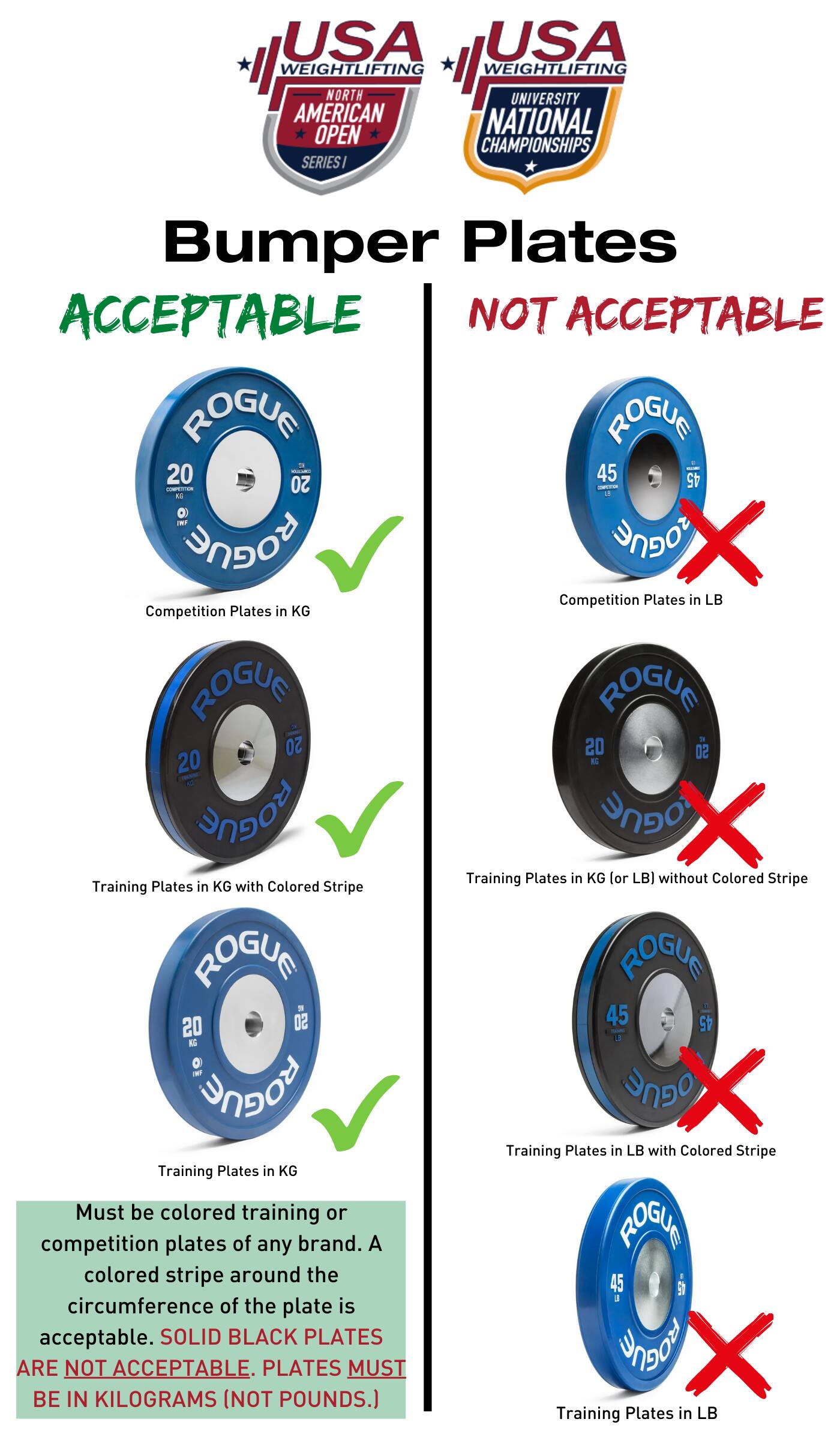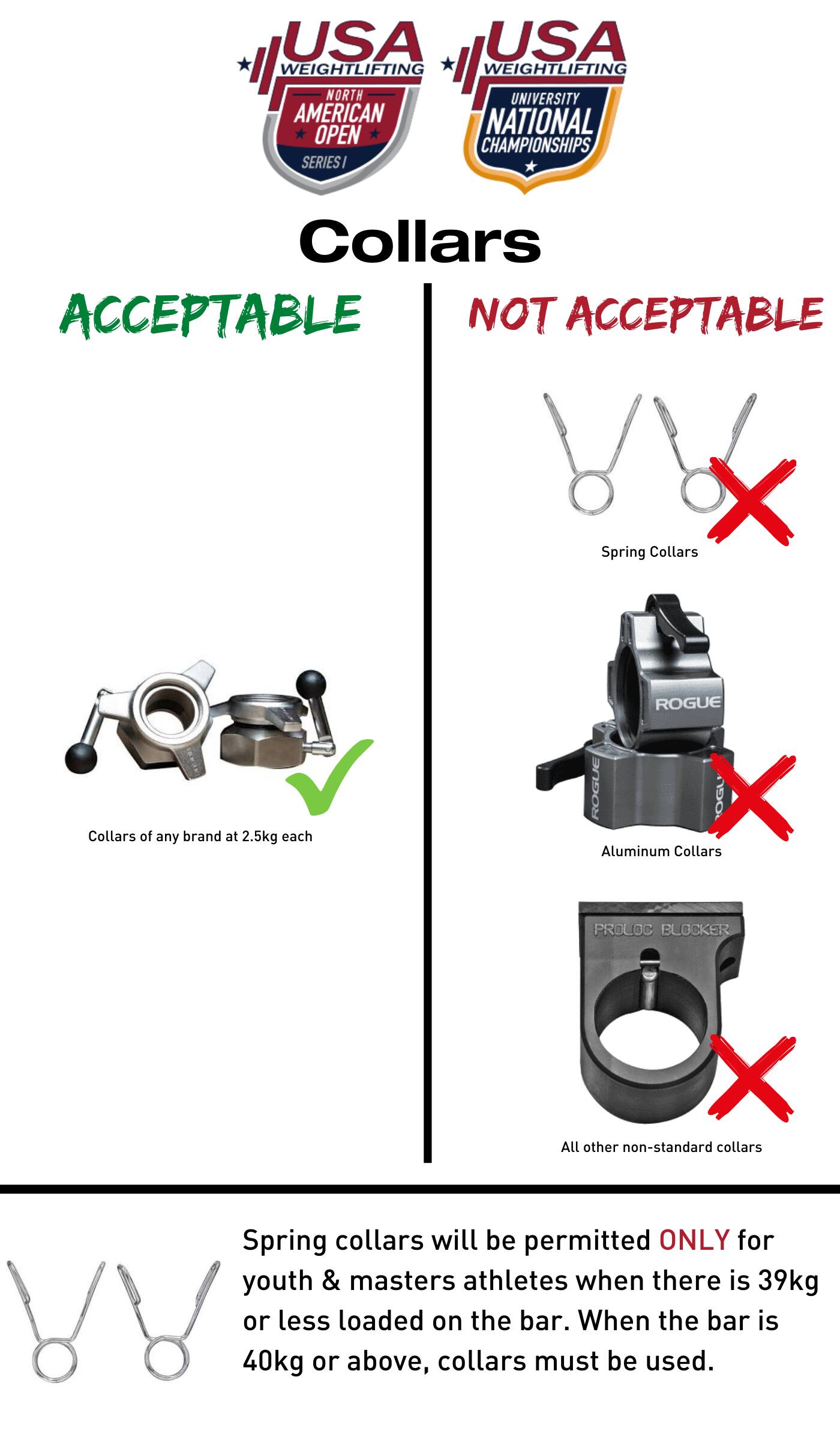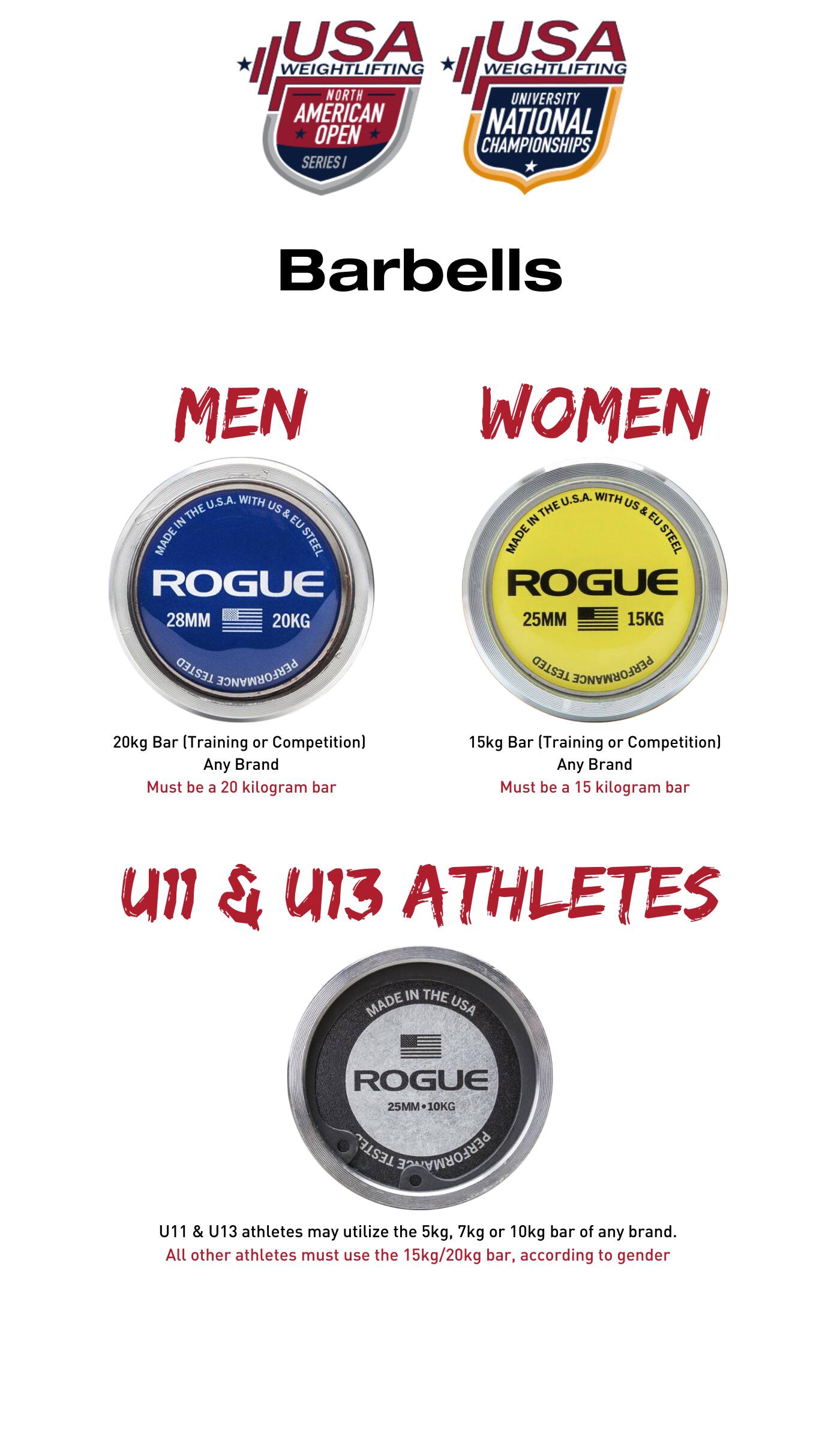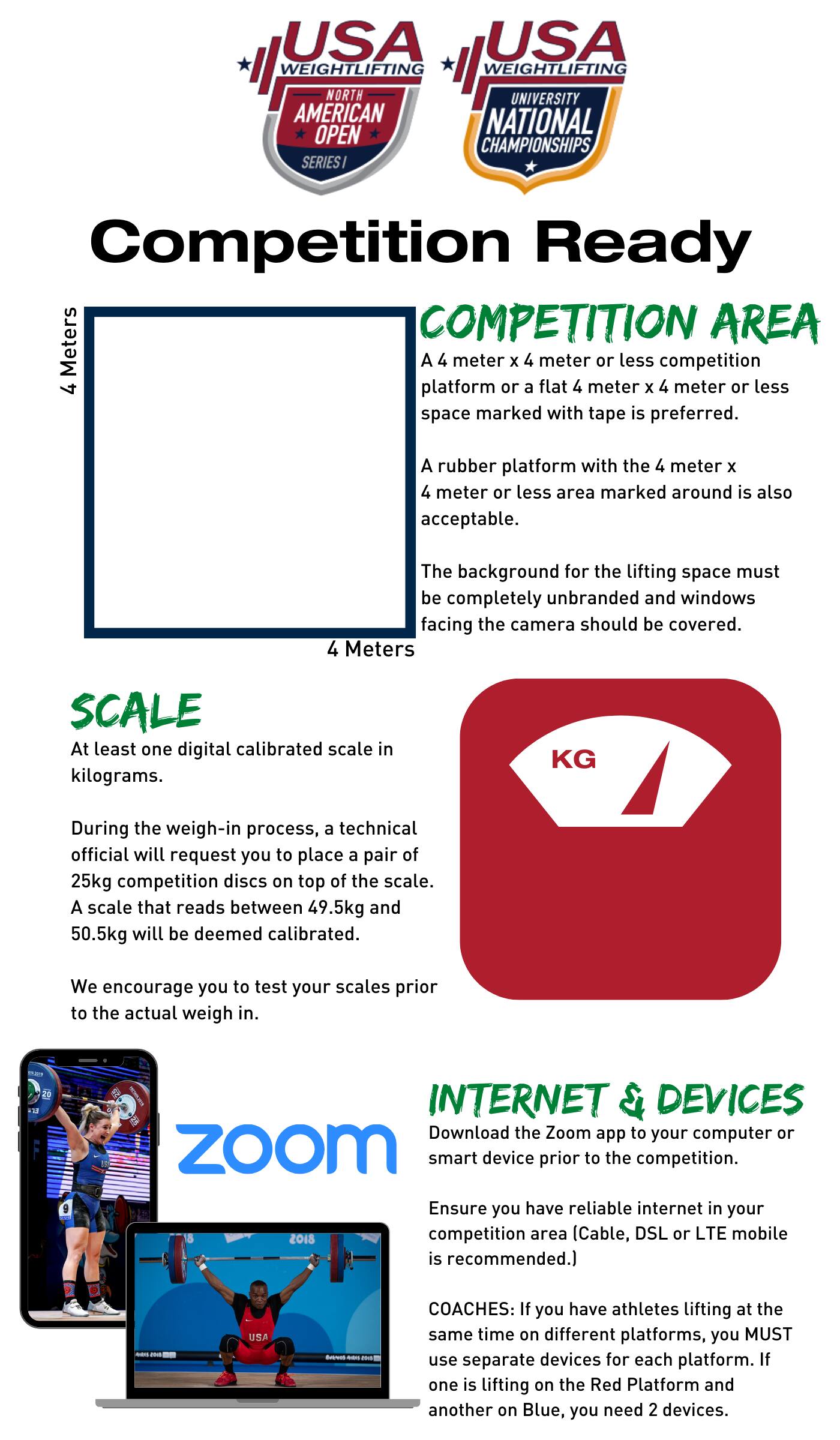Click each image to enlarge. Scroll down for more rule updates governing the competition.
2022 Rules Modification
1) REGULATION TO 2.2 – SPECIAL COMPETITION RULES FOR THE TWO LIFTS
a) THE SNATCH
The barbell is centered horizontally on the center of the Lifting Area / Platform. The athlete takes the start position behind the barbell. The athlete grips the barbell and bends at the knees. The barbell is gripped, palms downward and pulled in a single movement from the Lifting Area / Platform to the full extent of both arms above the head, while either splitting or bending the legs. During this continuous movement upward the barbell should remain close to the body and may slide along the thighs. No part of the body other than the feet may touch the Lifting Area / Platform during the execution of the Snatch. The athlete may recover in his/her own time, either from a split or a squat position. The lifted weight must be maintained in the final motionless position, with both arms and legs fully extended and feet on the same line and parallel to the plane of the trunk and the barbell. At this point the athlete must be stationary and in control of the barbell before the lift is deemed to be complete.
The athlete at his/her own discretion decides if the lift is complete according to the rule as stated above. Then the athlete lowers the barbell in front of the body releasing his/her grip on the barbell only after it has passed the level of the shoulders.
b) THE CLEAN & JERK
The First Part, the Clean:
The barbell is centered horizontally on the center of the Lifting Area / Platform. The athlete takes the start position behind the barbell. The athlete grips the barbell and bends at the knees. The barbell is gripped, palms downward and pulled in a single movement from the Lifting Area / Platform to the shoulders, while either splitting or bending the legs. During this continuous movement upward the barbell should remain close to the body and the barbell may slide along the thighs. The barbell must not touch the chest before it stops at the final position either on the clavicles, chest or on fully bent arms. The athlete's feet must return to the same line and the legs must be fully extended before starting the Jerk. No part of the body other than the feet may touch the Lifting Area / Platform during the execution of the Clean. The athlete may recover in his/her own time and must finish with the feet on the same line and parallel to the plane of the trunk and the barbell.
The Second Part, the Jerk:
The athlete must become motionless with the knees fully extended before starting the Jerk. The athlete bends and dynamically extends the legs and arms simultaneously to move the barbell upward in one motion to the full extent of the arms, while either splitting or bending the legs. The athlete returns his/her feet to the same line parallel to the plane of the trunk and the barbell with his/her arms and legs fully extended. At this point the athlete must be stationary and in control of the barbell before the lift is deemed to be complete.
The athlete at his/her own discretion decides if the lift is complete according to the rule as stated above. Then the athlete lowers the barbell in front of the body releasing his/her grip on the barbell only after it has passed the level of the shoulders.
2) REGULATION TO 6.6 – WEIGH-IN
a. All athletes will be required to weigh-in with a singlet.
b. Athletes will have a 0.5kg tolerance on their body weight division for the weigh-in. For example, an athlete that steps on a scale and weighs up to 48.5kg will still be eligible for the 48kg weight class.
c. All athletes will be required to weigh-in using a DIGITAL scale with kilograms displayed.
3) REGULATION TO 6.6.7 – LOADING AND START OF THE CLOCK
a. A bar will be considered loaded as soon as an athlete puts on a change at the marshal table through the zoom chat. After that, the clock should start for that athlete after the announcer says the Athlete Name and the Weight on the Bar.
4) REGULATION TO 6.6.7 – CONSECUTIVE ATTEMPTS
a. When an athlete attempts two (2) lifts in succession, he / she is allowed three (3) minutes (180 seconds) for the succeeding attempt.
5) REGULATION TO 7.5 – DECISION MAKING PROCESS FOR ATTEMPTS WITH LOADING ERRORS
a. If the barbell is loaded to a heavier weight than the one requested by the athlete, the athlete must accept the attempt if it was successful but will only be credited with the weight originally requested for that attempt. If the lift is not successful, the attempt will be scored as NO LIFT.
a. If the barbell is loaded to a lighter weight than the one requested, successful or not the lift will be scored as NO LIFT.
a. If the barbell is loaded to a weight that is not a multiple of 1 kg and the lift is successful, the weight on the barbell would need to have been a minimum of .5 kg heavier than the weight requested for the athlete to be credited with the weight originally requested. If the barbell is loaded lighter than the weight requested the attempt will be scored as NO LIFT.
Participants will be required to have the following equipment:
1) - One 15kg Weightlifting bar and/or one 20kg Weightlifting bar. Competing athletes will lift using a barbell in accordance to their gender, age group and with the IWF Technical and Competition Rules and Regulations (TCRR).
a. When applicable, athletes competing in the Under 13 and Under 11 age divisions are able to use 10kg or 5kg bars in order to complete their lifts.
2) Enough pairs of 25kg colored plates to load the bar according to competition standards. The barbell must be loaded according to the IWF TCRR at all times.
3) Enough pairs of the following colored plates: 20kg, 15kg, 10kg, 5kg, 2.5kg, 2.0kg, 1.5kg, 1.0kg, 0.5kg to load the bar according to competition standards. The barbell must be loaded according to the IWF TCRR at all times.
4) A 4 x 4m, or smaller, competition platform or a flat 4 x 4m, or smaller, space marked with tape. A rubber platform with the 4 x 4m area marked around is also acceptable. The background for the lifting space must be completely unbranded. A space bigger than 4 x 4m will not be accepted.
5) At least one calibrated DIGITAL scale in kilos. A tolerance of 0.5kg will be applied for every bodyweight category (e.g. an athlete registered for the 49kg bodyweight category can compete with a bodyweight of 49.50kg or less).
7) Reliable onsite WiFi that will be used to participate in the remote live competition.
8) Adequate space to abide by local COVID-19 guidelines from your local authorities.
9) A technical official will verify each athlete’s equipment and competition area during weigh in. During the competition, the barbell must be loaded according to the IWF rules and regulations at all times.
Athletes will be able to compete from their home gym, or if a home gym is not available, at a gym of their choosing. This gym must not contain more than 2 athletes per session competing at the same time with a maximum building occupancy of ten. Should a local law or ordinance order fewer than ten people congregate, the site must follow those orders, along with any other health orders in effect.
Competition
For certain competitions, there will be Juries for A sessions. When in the first instance, a three-person Jury unanimously disagrees with the Referees’ decision, the Lift will be immediately overturned / reversed without discussion.
The competition will be held like a traditional weightlifting meet, with athletes declaring weights and lifting in order of the weight on the bar, following all of the rules set out in the IWF Technical and Competition Rules and Regulations (TCRR).
There will be no down signal. Athletes will be responsible for showing control of the bar overhead, and may release it when they feel they have shown control.
For weight declarations and changes during the competition, this event will follow the rules laid out in IWF Technical and Competition Rules and Regulations (TCRR). It is highly recommended that athletes and coaches read the relevant sections to ensure they are ready for competition. Changes will be accepted via the chat box, sent to everyone, in the Zoom meeting.
2021 Rules Modifications
1) REGULATION TO 2.2 – SPECIAL COMPETITION RULES FOR THE TWO LIFTS
a) THE SNATCH
The barbell is centered horizontally on the center of the Lifting Area / Platform. The athlete takes the start position behind the barbell. The athlete grips the barbell and bends at the knees. The barbell is gripped, palms downward and pulled in a single movement from the Lifting Area / Platform to the full extent of both arms above the head, while either splitting or bending the legs. During this continuous movement upward the barbell should remain close to the body and may slide along the thighs. No part of the body other than the feet may touch the Lifting Area / Platform during the execution of the Snatch. The athlete may recover in his/her own time, either from a split or a squat position. The lifted weight must be maintained in the final motionless position, with both arms and legs fully extended and feet on the same line and parallel to the plane of the trunk and the barbell. At this point the athlete must be stationary and in control of the barbell before the lift is deemed to be complete.
The athlete at his/her own discretion decides if the lift is complete according to the rule as stated above. Then the athlete lowers the barbell in front of the body releasing his/her grip on the barbell only after it has passed the level of the shoulders.
b) THE CLEAN & JERK
The First Part, the Clean:
The barbell is centered horizontally on the center of the Lifting Area / Platform. The athlete takes the start position behind the barbell. The athlete grips the barbell and bends at the knees. The barbell is gripped, palms downward and pulled in a single movement from the Lifting Area / Platform to the shoulders, while either splitting or bending the legs. During this continuous movement upward the barbell should remain close to the body and the barbell may slide along the thighs. The barbell must not touch the chest before it stops at the final position either on the clavicles, chest or on fully bent arms. The athlete's feet must return to the same line and the legs must be fully extended before starting the Jerk. No part of the body other than the feet may touch the Lifting Area / Platform during the execution of the Clean. The athlete may recover in his/her own time and must finish with the feet on the same line and parallel to the plane of the trunk and the barbell.
The Second Part, the Jerk:
The athlete must become motionless with the knees fully extended before starting the Jerk. The athlete bends and dynamically extends the legs and arms simultaneously to move the barbell upward in one motion to the full extent of the arms, while either splitting or bending the legs. The athlete returns his/her feet to the same line parallel to the plane of the trunk and the barbell with his/her arms and legs fully extended. At this point the athlete must be stationary and in control of the barbell before the lift is deemed to be complete.
The athlete at his/her own discretion decides if the lift is complete according to the rule as stated above. Then the athlete lowers the barbell in front of the body releasing his/her grip on the barbell only after it has passed the level of the shoulders.
2) REGULATION TO 6.6 – WEIGH-IN
a. All athletes will be required to weigh-in with a singlet.
b. Athletes will have a 0.5kg tolerance on their body weight division for the weigh-in. For example, an athlete that steps on a scale and weighs up to 49.5kg will still be eligible for the 49kg weight class.
c. All athletes will be required to weigh-in using a DIGITAL scale with kilograms displayed.
3) REGULATION TO 6.6.7 – LOADING AND START OF THE CLOCK
a. A bar will be considered loaded as soon as an athlete puts on a change at the marshal table through the zoom chat. After that, the clock should start for that athlete after the announcer says the Athlete Name and the Weight on the Bar.
4) REGULATION TO 7.5 – DECISION MAKING PROCESS FOR ATTEMPTS WITH LOADING ERRORS
a. If the barbell is loaded to a heavier weight than the one requested by the athlete, the athlete must accept the attempt if it was successful but will only be credited with the weight originally requested for that attempt. If the lift is not successful, the attempt will be scored as NO LIFT.
a. If the barbell is loaded to a lighter weight than the one requested, successful or not the lift will be scored as NO LIFT.
a. If the barbell is loaded to a weight that is not a multiple of 1 kg and the lift is successful, the weight on the barbell would need to have been a minimum of .5 kg heavier than the weight requested for the athlete to be credited with the weight originally requested. If the barbell is loaded lighter than the weight requested the attempt will be scored as NO LIFT.
Participants will be required to have the following equipment:
1) - One 15kg Weightlifting bar and/or one 20kg Weightlifting bar. Competing athletes will lift using a barbell in accordance to their gender, age group and with the IWF Technical and Competition Rules and Regulations (TCRR).
a. When applicable, athletes competing in the Under 13 and Under 11 age divisions are able to use 10kg or 5kg bars in order to complete their lifts.
2) Enough pairs of 25kg colored plates to load the bar according to competition standards. The barbell must be loaded according to the IWF TCRR at all times.
3) Enough pairs of the following colored plates: 20kg, 15kg, 10kg, 5kg, 2.5kg, 2.0kg, 1.5kg, 1.0kg, 0.5kg to load the bar according to competition standards. The barbell must be loaded according to the IWF TCRR at all times.
4) One pair of training or competition collars weighing 2.5kg each.
a. Spring collars are only accepted for Youth and Master athletes with barbells loaded until 39kg. Bars loaded with 40kg or above MUST be loaded by using regular 2.5kg collars.
5) A 4 x 4m, or smaller, competition platform or a flat 4 x 4m, or smaller, space marked with tape. A rubber platform with the 4 x 4m area marked around is also acceptable. The background for the lifting space must be completely unbranded. A space bigger than 4 x 4m will not be accepted.
6) At least one calibrated DIGITAL scale in kilos. A tolerance of 0.5kg will be applied for every bodyweight category (e.g. an athlete registered for the 49kg bodyweight category can compete with a bodyweight of 49.50kg or less).
7) Reliable onsite WiFi that will be used to participate in the remote live competition.
8) Adequate space to abide by local COVID-19 guidelines from your local authorities.
9) A technical official will verify each athlete’s equipment and competition area during weigh in. During the competition, the barbell must be loaded according to the IWF rules and regulations at all times.
Athletes will be able to compete from their home gym, or if a home gym is not available, at a gym of their choosing. This gym must not contain more than 2 athletes per session competing at the same time with a maximum building occupancy of ten. Should a local law or ordinance order fewer than ten people congregate, the site must follow those orders, along with any other health orders in effect.
Competition
For certain competitions, there will be Juries for A sessions. When in the first instance, a three-person Jury unanimously disagree with the Referees’ decision, the Lift will be immediately overturned / reversed without discussion.
The competition will be held like a traditional weightlifting meet, with athletes declaring weights and lifting in order of the weight on the bar, following all of the rules set out in the IWF Technical and Competition Rules and Regulations (TCRR).
There will be no down signal. Athletes will be responsible for showing control of the bar overhead, and may release it when they feel they have shown control.
For weight declarations and changes during the competition, this event will follow the rules laid out in IWF Technical and Competition Rules and Regulations (TCRR). It is highly recommended that athletes and coaches read the relevant sections to ensure they are ready for competition. Changes will be accepted via the chat box, sent to everyone, in the Zoom meeting.



